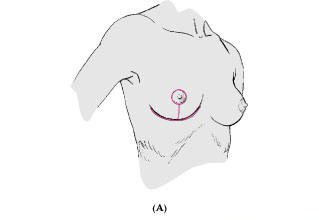Reasons for Wanting Smaller Breasts
Some women have excessively large breasts, causing pain and discomfort in the neck and back. Breast size can be reduced to relieve these distressing symptoms. The other reason for breast reduction is to make both breasts the same size, as a smaller breast can result from previous surgery or birth abnormality. Personal preferences and perception of beauty are also recognised reasons for wanting smaller breasts.
The operation involves removal of skin and breast tissue, and re-positioning the nipple. The surgeon usually draws out the incision lines on the breast just before surgery. The resulting scars are shown in the images below. However, the lower (horizontal) scar is not usually visible unless the breast is lifted upwards. The scars usually heal very well and become much less prominent with time. Despite this fairly major surgery, most patients experience minimal post-operative pain that is easily controlled with oral painkillers, such as Neurofen or paracetamol. The breasts are also lifted by this operation.




The Problems of Breast Reduction
Although most patients undergoing breast reduction are pleased with the symptomatic relief brought about by the operation, some women experience important complications.
Breast Asymmetry
It is extremely difficult to achieve exact symmetry during breast reduction surgery. In most cases, the degree of asymmetry is mild and acceptable to the patient. Further corrective surgery may be considered for severe asymmetry.
Loss of the Nipple
The removal of breast tissue during the operation can occasionally result in damage to the blood vessels supplying the nipple area. If this happens, the nipple area will gradually die off within the first few days after surgery (1-5% of cases). This is more likely to occur in large reductions when more than 1.5 kg of tissue is removed from each breast, and in smokers. Some surgeons avoid this complication by removing the nipple area at the beginning of the operation and then grafting it on to the new site at the end of the operation. The transplanted nipple will have no sensation.
Reduced Sensation in the Nipple Area
This complication occurs in up to a quarter of patients. Cutting some of the sensory nerves supplying the nipple area causes it.
Other Complications
These include wound infections, wound breakdown, blood collecting under the wound (haematoma) and lumps caused by the death of some of the fatty tissue in the breast (known as fat necrosis). All can be treated easily and usually resolve quickly.
Warning!
As there may be reduction in sensation to the skin over the breast (for reasons explained already), you may not be able to feel pain there as readily and damage to the skin may result. This commonly happens with the use of hot water bottles on the chest – the heat is not felt as severely and can result in burns.
Potential complications and risks of Breast Reduction Surgery:
- Bleeding Haematoma
- Infection leading to wound breakdown
- Fat necrosis
- Interference with nipple sensation and contractility
- Loss of sensation in the breast skin and nipple areola complex
- Breast asymmetry and irregularity of the nipple areola complex
- Unfavourable scarring including keloid scars
- Chronic Pain
- Recurrence of breast drooping (ptosis) and breast enlargement
- Anaplastic large cell lymphoma (very small risk)
- General anaesthetic risks: DVT (Vein clot), PE (Lung clot) and MI (Heart attack).


